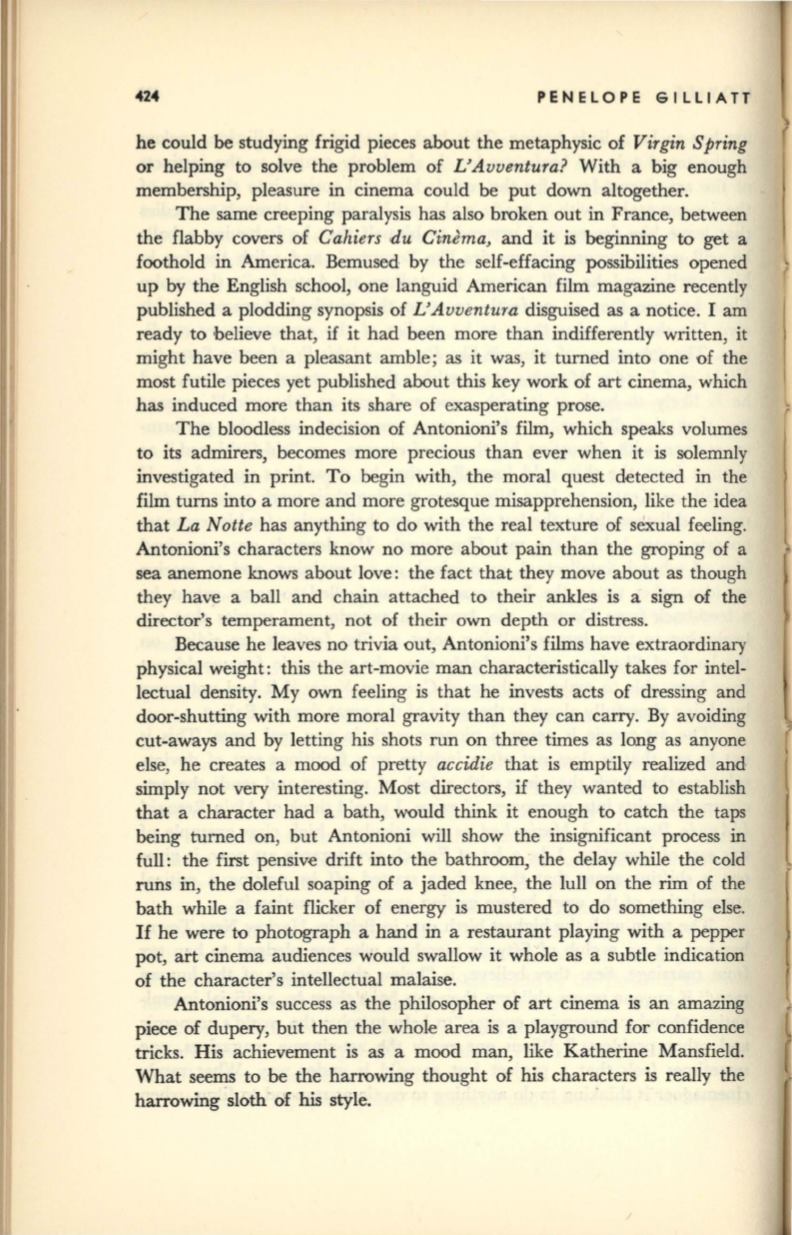
424
PENELOPE GILLIATT
he
could be studying frigid pieces about the metaphysic of
Virgin Spring
or helping to solve the problem of
L'Avventura?
With a big enough
membership, pleasure in cinema could be put down altogether.
The same creeping paralysis has also broken out in France, between
the flabby covers of
Cahiers du Cinema,
and it is beginning
to
get a
foothold in America. Bemused by the self-effacing possibilities opened
up by the English school, one languid American film magazine recently
published a plodding synopsis of
L'Avventura
disguised as a notice. I am
ready to believe that,
if
it had been more than indifferently written, it
might have been a pleasant amble; as it was, it turned into one of the
most futile pieces yet published about this key work of art cinema, which
has induced more than its share of exasperating prose.
The bloodless indecision of Antonioni's film, which speaks volumes
to its admirers, becomes more precious than ever when it is solemnly
investigated in print. To begin with, the moral quest detected in the
film turns into a more and more grotesque misapprehension, like the idea
that
La Notte
has anything to do with the real texture of sexual feeling.
Antonioni's characters know no more about pain than the groping of a
sea anemone knows about love: the fact that they move about as though
they have a ball and chain attached to their ankles is a sign of the
director's temperament, not of their own depth or distress.
Because he leaves no trivia out, Antonioni's films have extraordinary
physical weight: this the art-movie man characteristically takes for intel–
lectual density. My own feeling is that he invests acts of dressing and
door-shutting with more moral gravity than they can carry. By avoiding
cut-aways and by letting his shots run on three times as long as anyone
else, he creates a mood of pretty
accidie
that is emptily realized and
simply not very interesting. Most directors,
if
they wanted to establish
that a character had a bath, would think it enough to catch the taps
being turned on, but Antonioni will show the insignificant process in
full: the first pensive drift into the bathroom, the delay while the cold
runs in, the doleful soaping of a jaded knee, the lull on the rim of the
bath while a faint flicker of energy is mustered to do something else.
If
he were to photograph a hand in a restaurant playing with a pepper
pot, art cinema audiences would swallow it whole as a subtle indication
of the character's intellectual malaise.
Antonioni's success as the philosopher of art cinema is an amazing
piece of dupery, but then the whole area is a playground for confidence
tricks. His achievement is as a mood man, like Katherine Mansfield.
What seems to be the harrowing thought of his characters is really the
harrowing sloth of his style.


